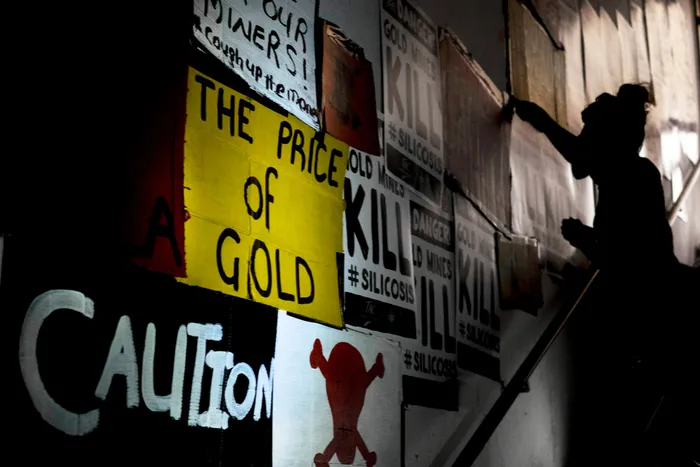‘Symbolic payments unlikely to change lives of miners, families’

File Picture: Shayne Robinson / Section 27 - An activist prepares a powerful interactive photograph exhibition at the Central Methodist Church of the 56 miners and families who are applicants in the Silicosis case.
By Trevor Ngwane
Hundreds of thousands of black workers suffered extended exposure to silica dust when digging gold at the behest of South African mining capital. Many of them contracted silicosis, an incurable, progressive and potentially fatal disease that permanently scars the lungs and makes the patient vulnerable to TB.
After more than a century of getting away with this crime against humanity, the day of reckoning for the mine owners has come.
In May 2016, the South Gauteng High Court approved a class action suit under common law to force goldmine owners to take responsibility for and pay compensation to the living and dead victims of what film-maker, Richard Pakleppa, in his documentary, Dying for Gold, called their “genocidal” wilful negligence.
In his judgment, Deputy Judge President Phineas Mojapelo wanted the 69 litigants’ lawyers to prove their argument that “all the mining companies sacrificed the health and safety of the mineworkers to maximise the profits they could extract from mining operations”.
Generations of black men were made to work underground in conditions that mine bosses and medical experts knew would cause many of them to contract the debilitating lung disease.
In 1902, a commission was established to inquire into the dangers of silicosis. Laws were passed to reduce white workers’ exposure to silica dust and their job duties were changed, with many becoming supervisors and spending less time doing dusty jobs.
A system was instituted to diagnose silicosis early and to allow them to be compensated and retire comfortably if they presented with symptoms of the disease. A few contracted TB.
Next to nothing was done to protect black workers and, over the decades, prevalence rates of silicosis were 20% to 30% among them.
In his book, Between the World and Me, African American author Ta-Nehisi Coates writes: “Black life is cheap, but in America, black bodies are a natural resource of incomparable value.” In other words, black lives and bodies were systematically degraded and devalued while generating immense wealth for the mine owners. They were made disposable because they were indispensable for capital accumulation.
The mine owners did not have the courage to face their day of reckoning.
After exposing their racist and profit-mongering value system, through their lawyers’ arguments, they opted for an out-of-court settlement.
In May 2018, six mining companies, led by Anglo American, agreed to compensate the sick and dead black miners, to the tune of R5 billion. This undoubtedly represents a victory in the struggle to hold capital accountable for the hardship and misery they impose on workers in the pursuit of profits.
Nonetheless, the struggle continues. The victory simply takes the fight to another level. The exploiter gives with one hand and takes with the other. The mine bosses were forced to reach a settlement; they did not suddenly see the light and the wrongness of their ways.
The settlement was approved by the court in July 2019, but it was only last month that we noticed movement in the payments to the sick miners and the families of those who died.
Many claimants have died of silicosis since the case was put to the courts by the miners’ lawyers in 2012.
They must now navigate bureaucratic hurdles of medical examination and documents to get their money.
The compensation will take the form of once-off lump sum payments, ranging from R10 000 to R500 000.
Already, R964.7 million has been paid out to 10 895 claimants, according to the Tshiamiso Trust set up by the mine owners to administer the fund.
The schedule of payment stipulates that Silicosis Class 1 awards are R70 000 for a claim where the patient presents with early symptoms of the disease. Class 2 pays R150000 and Class 3 R250000. Only in exceptional cases of “extraordinary disease conditions” will a claimant receive R500 000. In other words, these are “symbolic” payments that are unlikely to significantly change the lives of the miners and their families.
While the money is welcome and should be paid out as quickly as possible, the question remains whether and to what extent workers mining gold will continue contracting diseases.
The mine bosses claim, through their Mining Council, that they are reducing dust underground, but they have to do much more to convince health and safety experts.
Mining capital cannot be seen as buying itself out of responsibility and accountability.
The ANC government can do more to enforce regulations that protect workers against the risk of silicosis, TB and other occupational diseases such as making this a condition when issuing mining licences.
What mining capital did to black workers underlined how the capitalist system puts profit before people.
In colonial contexts, capital accumulation takes the form of “racial capitalism” and its racialised features and oppressions endure so long as its foundation, private property, remains protected and sacrosanct.
Ngwane is the Director of the Centre for Sociological Research and Practice at the University of Johannesburg.